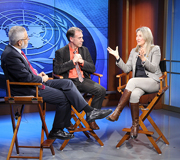
SDG indicators: The last missing piece of the 2030 Agenda
“Sustainable Development Goal indicators are the last missing piece to complete the architecture of the 2030 Sustainable Development Agenda,” explained Stefan Schweinfest, Director of UN DESA’s Statistics Division, ahead of the 47th Session of the UN Statistical Commission, which takes place at UN Headquarters on 8-11 March. At this annual meeting, Chief Statisticians will gather from all corners of the world to discuss statistical standards that will help generate better data for better lives.
In this year’s session, the Commission will continue its regular work, which covers all kinds of new areas such as refugees, climate change and big data. However, a special focus will be on the presentation of the global indicator framework for the goals and targets of the 2030 Agenda for Sustainable Development. The Commission is invited to agree on the SDG indicators and endorse a provisional workplan for the indicators that will require refinement as well as a proposed workplan for their implementation.
Developing a set of global indicators
The Inter-agency and Expert Group on Sustainable Development Goal Indicators (IAEG-SDGs), established by the Statistical Commission at its 46th session, has been tasked to develop the first ever indicator set for the post-2015 development agenda at the global level, and to support its implementation. Throughout this process, the views of all stakeholders were taken into account and their suggestions were reviewed and considered by the IAEG-SDGs.
“I am impressed by the level of consultation, involvement and participation that the process of setting these new universal indicators has involved and I would even dare to say that for the statistical community this is an unprecedented process. There has never been in the history of the world such an agreement,” said Assistant Secretary-General for Economic Development Lenni Montiel.
The IAEG members tried to ensure that the indicator selected best measured the target and that the indicator was not reinterpreting the target. “The most important job an indicator has to do, is to inform decision making and then ultimately change policies and behaviours and it can only do that if it is solid and credible and that is what we are striving for to build an information system at all levels that will do just that,” said Stefan Schweinfest.
Global indicator framework as a starting point
“There is a continuous need and a continuous willingness to engage and also to refine the tools”, continued Mr. Schweinfest. The global indicators will be complemented by indicators at the regional and national levels to be developed by Member States.
“The national statisticians are really driving the process. They have contributed to the discussion on the global indicators, but at the same time they are looking at their own national circumstances and deciding what they want to use at the national level. In some cases they come up with their own ideas and own proposals,” emphasized Francesca Perucci, Assistant Director and Chief of the Statistical Service Branch in UN DESA’s Statistics Division.
193 countries will have to compile the data for the indicators. National statistical offices will need the support of their own governments and the international communities to build capacities.
Leaving no one behind
Member States have pledged that no one would be left behind. In order to ensure that, the IAEG-SDG Members have agreed that indicators should cover the specific groups of population and other disaggregation elements specified in the targets. Furthermore, the Statistical Commission has created a mechanism through a High-level Group, which will provide strategic guidance to capacity building efforts and which will support countries with implementation of the SDG indicators.
“The future of the statistics in the world does not depend only on the UN, there is a larger set of organizations, groups and professionals that are all interconnected and positively interacting with the UN in different ways,” said Lenni Montiel.
New forms of collaboration ensure that we are moving in the right direction and if necessary adjust the tools and policies in order to achieve the 2030 Agenda.

Follow Us